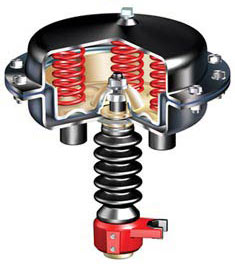|
|
The actuator diaphragm is said by the flexible diaphragm or membrane which separates two concave flattened chambers.
At least one of the cavities of the two chambers is connected to a pressure line that operates the actuator. The air pressure expands the diaphragm and
pulls the actuator stem into a linear motion. Generally, these actuators perform against a spring which is responsible for returning
back the diaphragm to its original position once the pressure of the chamber is off.
|
Acting Types:
• Direct acting: most of the diaphragm actuators are of this type. They have the pressure-tight chamber above the diaphragm. The actuator stem moves downward when the pressure within that chambers is increased.
• Reverse acting: the chamber under the diaphragm is pressured-tight and the spring mounting arrangement changed so an upward stem motion will compress it.
Many actuator designs allow to select one of both acting types when they are mounted in the field.
 The force that makes the actuator is the determined by the effective area of the diaphragm and the operation pressure
of the actuator. To this force should be subtracted the spring force.
The force that makes the actuator is the determined by the effective area of the diaphragm and the operation pressure
of the actuator. To this force should be subtracted the spring force.
The linear motion is a short stroke. Therefore these actuators are limited to be used on needle valve, globe valves, diaphragm valves and pinch valves.
